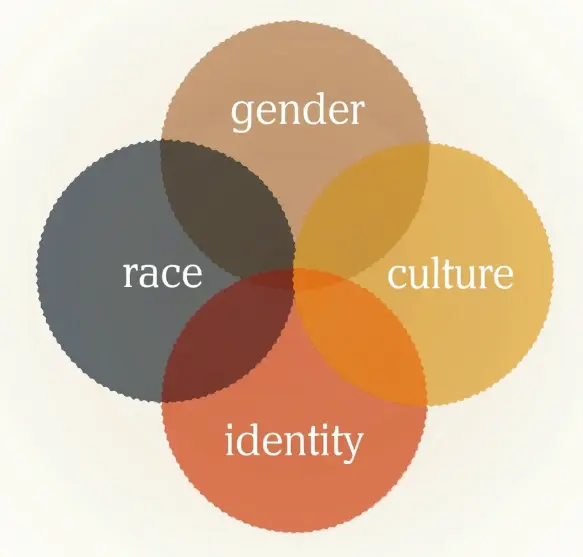Gender Fluid Explained: Understanding Shifting Gender Identities
Gender fluid describes a person whose gender identity changes over time. A gender fluid person may feel aligned with one gender, multiple genders, or no gender at different points. This challenges societal norms by embracing the fluid nature of gender beyond the binary concept of male and female.
Key Takeaways
Olgha Rybak (she/her) is Fiorry's Chief Editor, where she executes and operates in a writer, editor, and content creator capacity. At university, she studied English language and literature but found she loved psychology almost as much. Olgha is an industrious content creator as well as a committed team leader, with a unique perspective into the complicated nooks and crannies of human behavior and communication. As a hobby, Olgha translates literature, passionately reading and seeking out stories that she'll be completely absorbed by.

Introduction to Genderfluidity Definition
Gender fluidity means embracing a flexible gender identity that shifts over time. It is part of the LGBTQIA+ spectrum, which includes diverse gender expressions and sexual orientations. Gender fluidity recognizes that a person’s gender identity isn’t always fixed—it can change daily, weekly, or at any time.
This concept challenges the traditional gender binary, emphasizing that gender exists on a spectrum rather than as rigid categories of male or female.
Being genderfluid means having unique dating needs. If you’re looking for people who understand that, start with trans dating near me.
What Does Genderfluid Mean?
So, what does gender fluid mean? To define genderfluid is to understand it as a person whose gender identity can change over time, regardless of the sex assigned at birth. The term “genderfluid” combines “gender” with “fluid,” and linguistically, “fluid” suggests flexibility, which aligns with the idea that gender is not fixed.
Culturally, genderfluidity challenges traditional binary norms that define gender as strictly male or female. It emphasizes that gender identity is personal and can fluctuate, reflecting a broader understanding of gender beyond rigid categories.
This concept is crucial to discussions of gender identity, as it allows people to express themselves in ways that align with their authentic experiences rather than societal expectations.
Understanding Gender Identity
Gender identity refers to how a person personally experiences and identifies their gender, which may or may not align with their biological sex.
Unlike biological sex, which is assigned at birth based on physical characteristics, gender identity is a deeply personal sense of being male, female, neither, or somewhere in between.
A fixed gender identity, on the other hand, refers to a stable and unchanging identification with one gender.
The gender spectrum includes both binary identities (male and female) and non-binary identities, such as genderfluid, agender, and genderqueer, which recognize that gender can be diverse and fluid rather than fixed.

Fluidity in Gender Expression
Gender fluid people may express their identity in various ways, shifting their appearance, behavior, and pronouns based on their feelings at any given time.
These gender identity shifts can be temporary, with some people feeling aligned with one gender for a period and then transitioning to another. Some may present traditionally feminine or masculine, while others may blend both or choose a more neutral expression.
Pronoun preferences also vary—some genderfluid people may use he, she, they, or even a mix depending on their gender experience at the moment. The key to gender fluidity is flexibility, as their gender experience can change and evolve, embracing the fluid nature of gender expression.
Exploring gender fluidity in your own life? Fiorry is here for you. Join a community that supports your journey.

Common Misconceptions About Genderfluidity
Several misconceptions about genderfluidity often lead to misunderstandings.
One common myth is that being genderfluid is ‘just a phase.’ In reality, the definition of genderfluidity shows it to be a valid and enduring identity for many people, not a temporary experience
Another misconception is that genderfluid people must have gender dysphoria, but gender fluidity and dysphoria are not the same.
Additionally, genderfluidity is often confused with other non-binary identities, but it is distinct in its fluid, changeable nature. Understanding these differences is key to respecting and supporting genderfluid people.
How Genderfluidity Fits Into the LGBTQIA+ Community
Genderfluid people represent one type of gender identity within the LGBTQIA+ community, contributing to the broader conversation about gender diversity and inclusivity.
As part of the non-binary spectrum, genderfluid people contribute to a more gender diverse understanding of identity, challenging the binary norms of male and female. Inclusivity within the LGBTQIA+ community is vital, as it ensures that all people, regardless of their gender expression or experience, feel seen and supported.
Representation of genderfluid people in media, advocacy, and policy is crucial for visibility and acceptance, promoting a more inclusive society where everyone can express their authentic selves.

Intersectionality and Genderfluidity
Genderfluidity intersects with various aspects of identity, including race, culture, religion, and other personal experiences.
Just as genderfluid people experience shifting gender identities, their cultural, racial, and religious backgrounds can shape how they express and experience gender. For example, a genderfluid person who identifies as a person of color may navigate both racial and gender identity complexities, facing different challenges than someone with a more dominant cultural background.
Similarly, religious beliefs and cultural norms can influence how genderfluid people are perceived and supported. These intersecting identities highlight the diversity within the genderfluid community, showing that their experiences are as varied as their individual backgrounds and life stories.
Challenges Faced by Genderfluid people
Genderfluid people often face numerous challenges, both socially and emotionally.
Genderfluid man and woman often face discrimination and a lack of visibility, which can lead to marginalization, rejection, and even violence. These challenges are compounded by societal expectations to conform or the experience of being misgendered.
Such pressures contribute to mental health struggles, including anxiety and depression, highlighting the need for greater awareness and support.

We need to stop questioning people’s identities and just accept them as they are. We need to normalize fluidity and respect the fluidity in all of us

Navigating Relationships as a Genderfluid Person
Genderfluidity can influence romantic, platonic, and familial relationships.
In romantic relationships, changes in gender identity can affect attraction, pronouns, and intimacy preferences, requiring open communication and flexibility from both partners.
In platonic and familial relationships, friends and family may need to adapt to shifting gender expression and identity. This can create challenges, but with mutual respect and understanding, these relationships can remain strong and supportive as they evolve.
Supporting Genderfluid people
Supporting genderfluid people involves using the correct pronouns, which may change depending on their gender identity at any given time. Respecting their shifting gender expression and identity, even when it changes, is essential. Allies, friends, and family can show support by educating themselves about gender fluidity, advocating for inclusive policies, and listening to the experiences of genderfluid people. Creating safe spaces where genderfluid people feel validated is key to fostering their mental well-being.
Looking for a place to connect with others who understand? Join the perfect location for trans dating today – Fiorry.
Resources for Education and Support
For those seeking to learn more about genderfluidity and gender diversity, there are numerous resources available:
Books:
Articles:
- “Understanding Gender Fluidity” from Psychology Today
- “What is Genderfluid?” on Healthline
Support Groups and Organizations:
- The Trevor Project (offers support for LGBTQ youth)
- PFLAG (provides education and advocacy for LGBTQ+ people and their families)
These resources offer valuable insights and support for anyone seeking to understand or support genderfluid people.
Celebrating Genderfluidity
Genderfluid people don’t stick to one gender. It can change over time or day to day. For some, it’s clear and settled. For others, it shifts. This isn’t new. It’s just often ignored.
When people see others like them in public life, they feel less alone. That includes actors, musicians, and people on social media. Ruby Rose and Indya Moore are two well-known examples. But there are many more sharing their own stories online. These stories help explain things simply and show that genderfluidity isn’t rare.
Flags and symbols matter too. They show that someone belongs. They say, “You’re not the only one.”
Some shows now include genderfluid characters. The Umbrella Academy and Pose are examples. These characters aren’t there to teach a lesson. They’re just part of the story, like anyone else. That’s a change from how things used to be.
If you’re learning about this, listen to the people living it. Use the names and pronouns they ask for. Respect goes a long way.

Conclusion
Genderfluidity is an important and evolving aspect of the gender spectrum, challenging the rigid norms of the gender binary. It emphasizes that gender identity is not fixed but can shift over time, reflecting a more nuanced understanding of gender.
By understanding the experiences of genderfluid people, we contribute to a more inclusive and accepting society. Celebrating gender diversity, offering support, and providing visibility in media and culture help create an environment where everyone can express their authentic selves. Embracing genderfluidity promotes respect, equality, and acceptance for all identities.
FAQ
What is the difference between bigender and genderfluid?
Bigender people experience two distinct genders, while genderfluid people’s gender identity can shift between multiple genders over time.
What does genderfluid mean sexually?
Genderfluidity refers to a person’s gender identity changing over time, and it is not inherently tied to sexual attraction. A genderfluid person’s sexual orientation can vary, just like anyone else’s. They may be attracted to people of any gender, depending on their own gender identity and feelings at the time.
Can you be lesbian and genderfluid?
Yes, a genderfluid person can identify as lesbian when their gender aligns with female. Genderfluidity allows for fluid attraction and identity shifts
Ready to meet people who understand your gender identity? Fiorry is your go-to platform



Gender theorist
Kate Bornstein
Gender is not something you’re born with; it’s something you learn. Fluidity is an option, and it’s essential to embrace that option to live authentically